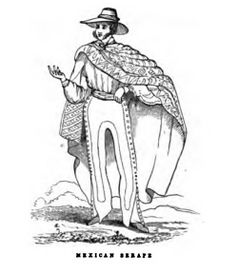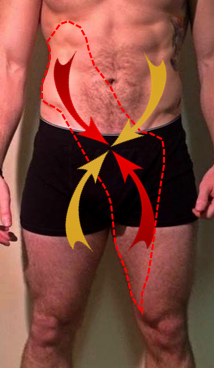Serape effect: Difference between revisions
Ahmed Nasr (talk | contribs) No edit summary |
Kim Jackson (talk | contribs) mNo edit summary |
||
| (One intermediate revision by the same user not shown) | |||
| Line 1: | Line 1: | ||
<div class="editorbox"> '''Original Editor '''- [[User:User Name|Ahmed Nasr]] '''Top Contributors''' - {{Special:Contributors/{{FULLPAGENAME}}}}</div> | |||
== Description == | == Description == | ||
[[File:Mexican Serape.jpg|thumb|273x273px]] | [[File:Mexican Serape.jpg|thumb|273x273px]] | ||
The term serape | The term serape originates from Mexico, it is a form of cloth that looks like a long blanket-like shawl worn by Mexicans. | ||
There are a group of muscles, in the body, that attach together by fascia forming the same shape of the serape .<ref name=":0">Juan CS. The Serape Effect: A Kinesiological Model for Core Training. National Strength & Conditioning Association. April 2003:25(2):73–74.</ref> | |||
These muscles | These muscles when working together create a give a high force during ballistic motions, such as throwing or kicking.That is why the power they generate is known as the serape effect. | ||
{{#ev:youtube|1JfUrRiDNxs}} | {{#ev:youtube|1JfUrRiDNxs}} | ||
== Muscles of the Serape | == Muscles of the Serape<ref name=":0" /> == | ||
* Ipsilateral Rhomboids | * Ipsilateral Rhomboids | ||
* Ipsilateral Serratus anterior | * Ipsilateral Serratus anterior | ||
| Line 16: | Line 17: | ||
* Contralateral adductors | * Contralateral adductors | ||
Serratus anterior has a direct attachment to external abdominal obliques. Therefore during rehabilitation to increase firing of Serratus anterior activation of the abdominal muscles and rotation causing stretching and a snap back effect, for example as in push ups, the bird dog exercise, and turn wall punch exercise<ref>De Araújo R C. Pirauá A L., Beltrão N B., Pitangui A C . Activity of periscapular muscles and its correlation with external oblique during push-up: Does scapular dyskinesis change the electromyographic response?. Journal of Sports Sciences. 2017:''36(5):571–577.''</ref> | |||
[[File:AOS Anatomy.png|thumb]] | [[File:AOS Anatomy.png|thumb]] | ||
It also | It also applies to the adductors, particularly adductor longus. Adductor longus has a direct attachment to the contralateral external abdominal oblique and ipsilateral internal abdominal obliques. Therefore using isometric hip adduction will recruit more abdominal muscles during plank exercises <ref>Kim S Y, Kang M H., Kim E R , Jung I G , Seo E Y, Oh J. ''Comparison of EMG activity on abdominal muscles during plank exercise with unilateral and bilateral additional isometric hip adduction. Journal of Electromyography and Kinesiology. 2016: 30: 9–14.''</ref> | ||
== Advantage == | == Advantage == | ||
* | * The serape effect will allow the athlete to generate a high force, ballistic movements in both the upper limb and lower limb. This is achieved by activating the trunk muscles and adding rotation to the upper or lower limbs. These movements act as a spring; when stretched the muscles will store potential energy which will be converted into kinetic energy during motion, this energy will be transmitted to the extremities, | ||
* | * Serape can be used during rehabilitation to achieve an advantage wherein weak or inhibited can be assisted by other muscles facilitating a stronger movement. | ||
== | == Strengthening Exercises == | ||
{| width="100%" cellspacing="1" cellpadding="1" | {| width="100%" cellspacing="1" cellpadding="1" | ||
|- | |- | ||
| Line 31: | Line 32: | ||
|{{#ev:youtube|MlNFPpU-Sxk|300}} | |{{#ev:youtube|MlNFPpU-Sxk|300}} | ||
|} | |} | ||
== References == | |||
<references /> | |||
[[Category:Interventions]] | |||
Latest revision as of 01:12, 9 August 2019
Description[edit | edit source]
The term serape originates from Mexico, it is a form of cloth that looks like a long blanket-like shawl worn by Mexicans.
There are a group of muscles, in the body, that attach together by fascia forming the same shape of the serape .[1]
These muscles when working together create a give a high force during ballistic motions, such as throwing or kicking.That is why the power they generate is known as the serape effect.
Muscles of the Serape[1][edit | edit source]
- Ipsilateral Rhomboids
- Ipsilateral Serratus anterior
- Ipsilateral external abdominal obliques
- Contralateral Internal abdominal obliques
- Contralateral adductors
Serratus anterior has a direct attachment to external abdominal obliques. Therefore during rehabilitation to increase firing of Serratus anterior activation of the abdominal muscles and rotation causing stretching and a snap back effect, for example as in push ups, the bird dog exercise, and turn wall punch exercise[2]
It also applies to the adductors, particularly adductor longus. Adductor longus has a direct attachment to the contralateral external abdominal oblique and ipsilateral internal abdominal obliques. Therefore using isometric hip adduction will recruit more abdominal muscles during plank exercises [3]
Advantage[edit | edit source]
- The serape effect will allow the athlete to generate a high force, ballistic movements in both the upper limb and lower limb. This is achieved by activating the trunk muscles and adding rotation to the upper or lower limbs. These movements act as a spring; when stretched the muscles will store potential energy which will be converted into kinetic energy during motion, this energy will be transmitted to the extremities,
- Serape can be used during rehabilitation to achieve an advantage wherein weak or inhibited can be assisted by other muscles facilitating a stronger movement.
Strengthening Exercises[edit | edit source]
References[edit | edit source]
- ↑ 1.0 1.1 Juan CS. The Serape Effect: A Kinesiological Model for Core Training. National Strength & Conditioning Association. April 2003:25(2):73–74.
- ↑ De Araújo R C. Pirauá A L., Beltrão N B., Pitangui A C . Activity of periscapular muscles and its correlation with external oblique during push-up: Does scapular dyskinesis change the electromyographic response?. Journal of Sports Sciences. 2017:36(5):571–577.
- ↑ Kim S Y, Kang M H., Kim E R , Jung I G , Seo E Y, Oh J. Comparison of EMG activity on abdominal muscles during plank exercise with unilateral and bilateral additional isometric hip adduction. Journal of Electromyography and Kinesiology. 2016: 30: 9–14.








